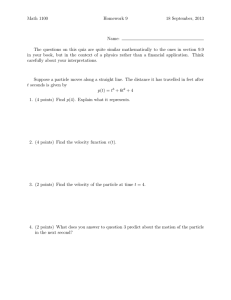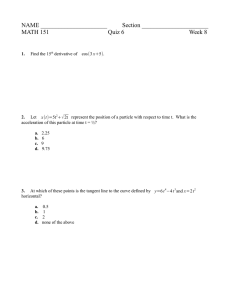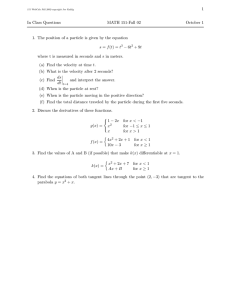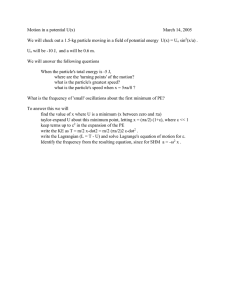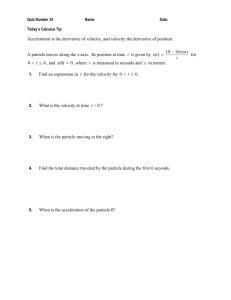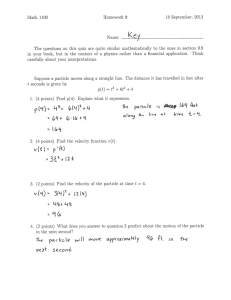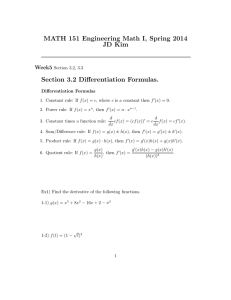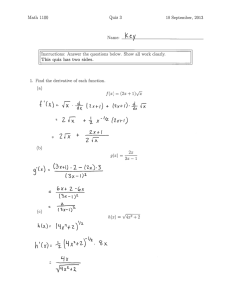Predictability of anomalous transport on lattice networks with quenched disorder Please share
advertisement
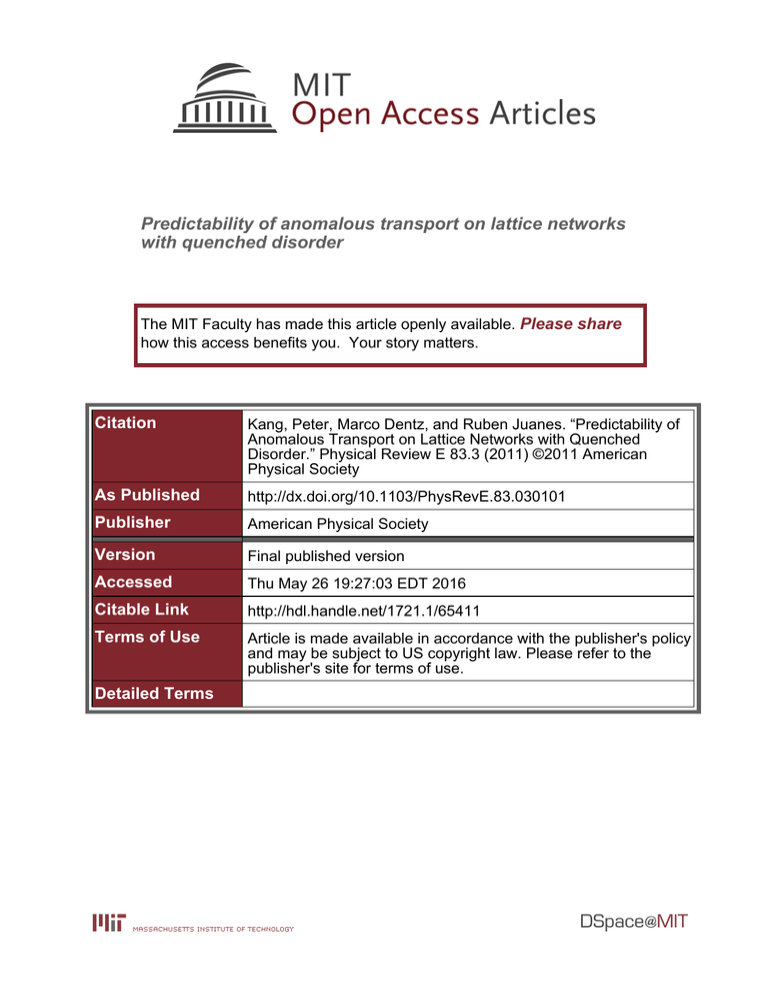
Predictability of anomalous transport on lattice networks
with quenched disorder
The MIT Faculty has made this article openly available. Please share
how this access benefits you. Your story matters.
Citation
Kang, Peter, Marco Dentz, and Ruben Juanes. “Predictability of
Anomalous Transport on Lattice Networks with Quenched
Disorder.” Physical Review E 83.3 (2011) ©2011 American
Physical Society
As Published
http://dx.doi.org/10.1103/PhysRevE.83.030101
Publisher
American Physical Society
Version
Final published version
Accessed
Thu May 26 19:27:03 EDT 2016
Citable Link
http://hdl.handle.net/1721.1/65411
Terms of Use
Article is made available in accordance with the publisher's policy
and may be subject to US copyright law. Please refer to the
publisher's site for terms of use.
Detailed Terms
RAPID COMMUNICATIONS
PHYSICAL REVIEW E 83, 030101(R) (2011)
Predictability of anomalous transport on lattice networks with quenched disorder
Peter K. Kang,1 Marco Dentz,2 and Ruben Juanes1,*
1
Massachusetts Institute of Technology, 77 Massachusetts Avenue, Building 48, Cambridge, Massachusetts 02139, USA
2
Spanish National Research Council (IDÆA-CSIC), E-08034 Barcelona, Spain
(Received 20 July 2010; published 4 March 2011)
We study stochastic transport through a lattice network with quenched disorder and evaluate the limits
of predictability of the transport behavior across realizations of spatial heterogeneity. Within a Lagrangian
framework, we perform coarse graining, noise averaging, and ensemble averaging, to obtain an effective transport
model for the average particle density and its fluctuations between realizations. We show that the average particle
density is described exactly by a continuous time random walk (CTRW), and the particle density variance is
quantified by a novel two-particle CTRW.
PACS number(s): 05.60.Cd, 05.10.Gg, 05.40.Fb, 92.40.Kf
Transport of individual agents on networks leads to the
emergence of collective dynamics that govern many processes
in nature and society, such as traffic patterns [1], evacuation
systems [2], bubble microfluidic devices [3], cell motility in
dense actin filament networks [4], and flow through geologic
fractures [5]. Recent analyses have led to key advances in the
theory of transport on networks, including an understanding
of the conductance between two arbitrarily chosen nodes in
scale-free or Erdős and Rényi networks [6], and spreading
behavior by means of diffusive random walks [7,8]. However,
predictive theories of the aggregate transport behavior are
still in their infancy and are likely to be one of the next
frontiers in network science [9]. This has proven challenging
because the dynamics depend on network topology as well
as on the underlying transport mechanisms, such as the
balance between advection and diffusion [10], or diffusion
and reaction [11,12]. Another fundamental challenge is that
the detailed properties of the network are often inaccessible to
direct observation. As a result, transport must be understood
in a stochastic framework, and characterizing the system
requires not only estimating the expected evolution, but also
evaluating its predictability—the confidence with which a
prediction can be made—at the level of individual agents [13]
and also in terms of the mean-field behavior [14].
Here, we show that the ensemble behavior of kinetic particle
transport in a lattice network with quenched disorder in particle
velocity can be described exactly by a continuous time random
walk (CTRW) [15–18]. This provides an exact coarse-grained
model for the expected value of particle density in space
and time, thereby advancing CTRW not only as an effective
modeling approach [5,19], but also as a stochastic description
that emanates from proper upscaling of the microscale [20].
The central result of this Rapid Communication is an
explicit stochastic averaging of the quenched disorder that
allows for the systematic quantification of the sample-tosample fluctuations in particle density about the expected
behavior. Fluctuation quantification for random walks has
been addressed previously in annealed random environments
[21,22]. While some annealed and quenched disorder scenarios
lead to the same average behavior (CTRW), they exhibit different fluctuation dynamics. Although much of the mean behavior
*
juanes@mit.edu
1539-3755/2011/83(3)/030101(4)
of our model can be understood from a one-dimensional
(1D) system [23], the fluctuation behaviors for 1D and twodimensional (2D) systems are fundamentally different. Here,
we address the predictability of random walks in a quenched
random environment by developing a novel two-particle
process that exactly describes the variability in particle density
among equiprobable realizations of the network’s quenched
disorder. Our theoretical model of the particle density variance
takes a form that is reminiscent of CTRW, and, therefore,
we coin it two-particle CTRW. This result sheds light on
the spatiotemporal characteristics of uncertainty propagation
and the predictability of transport through a network whose
properties are unconditioned to hard data.
We consider a lattice network consisting of two sets of
parallel equidistant intersecting links: one set at an angle
−α and the other at an angle +α with respect to the
x axis [Fig. 1(a)]. We assign i.i.d. random particle velocities
v 0 to each link. Different values of particle velocity are
assumed to be the result of microscale processes, such as
different conductance or adsorption rate. In particular, our
model is an analog for transport through a fracture network
Flow direction
(a)
15
(b)
10
5
l
DOI: 10.1103/PhysRevE.83.030101
+α
y
0
−5
−10
−15
0
5
10
15
20
25
30
x
FIG. 1. (Color online) (a) Schematic of the lattice network
considered here, with two sets of links with orientation {−α,+α}
with respect to the x axis, and lattice spacing l = 1. Each network
realization exhibits quenched disorder in the particle velocity, with
link velocities determined from an independent and identically
distributed (i.i.d.) process pv (v). (b) Representation of transport
through the network from particles released at the origin at t = 0.
Shown is the particle density (represented by circle size) at t = 30
for a single realization with β = 1.5. The random process generating
velocity disorder induces large fluctuations in the particle density
between realizations.
030101-1
©2011 American Physical Society
RAPID COMMUNICATIONS
PETER K. KANG, MARCO DENTZ, AND RUBEN JUANES
PHYSICAL REVIEW E 83, 030101(R) (2011)
xn+1 = xn + l cos α,
yn+1 = yn + ξn l sin α, (1a)
tn+1 = tn + τ (xn ,ξn ),
(1b)
where the noise ξn ∈ {−1,+1} is distributed according to
a two-valued Dirac δ function pξn = (1 − λ)δ(ξn + 1) +
λδ(ξn − 1). The Lagrangian velocity v(xn ,ξn ) at the (n + 1)th
step at node at xn depends on the noise ξn . The quenched random velocity is mapped onto the quenched random transition
time between nodes, τ (xn ,ξn ) = l/v(xn ,ξn ). At a given time t,
a particle is assigned to node xn as long as t < tn+1 . Thus, τ is
the transition time between nodes or, alternatively, the waiting
time at a node. The transition times between nodes are fixed but
independent, and their one point distribution ψ(τ ) is obtained
from the velocity distribution ψ(τ ) = lτ −2 pv (l/τ ) ∼ τ −(1+β) .
The system of discrete Langevin equations (1) describes
coarse-grained particle transport in a single realization of the
network. The particle position at a given time t is xnt , where
nt denotes the renewal process that describes the number
of steps needed to reach time t following Eq. (1b), that is,
nt = max {n|t tn }.
We characterize transport in terms of the propagator P (x,t)
of the initial impulse, that is, the probability density of finding
a particle at position x at time t, which is given in terms of the
particle trajectories xnt as
P (x,t) = δ(x − xnt ),
(2)
where the angular brackets · denote noise averaging over all
particles. Note that the Dirac δ is the limit of a discrete density
for L l.
We solve the transport problem in a single disorder
realization by particle tracking using Eq. (1). The simulated
particle densities display large sample-to-sample fluctuations
[Fig. 2(a)]. By averaging over a sufficient number of realizations, we obtain the mean particle density P (x,t) = P (x,t),
where the overbar (·) denotes ensemble averaging over all
15
15
10
(a)
10
0
0
−5
−5
5
10
10
−15
10 15 20 25 30 0
15
t = 30
5
5
10 15 20 25 30
0
10
5
-5
5
0
0
−5
−5
−10
−10
−15
0
0.01
β =1.5
(b)
−10
−10
−15
0
15
15
5
5
y
with homogeneous hydraulic properties (fracture spacing and
aperture) but with chemical heterogeneity. Due to adsorption,
the mean particle velocity within a link is lower than the
fluid velocity by a retardation factor R = 1 + k, where the
coefficient k is a measure of adsorption strength. Our analytical
developments are valid for any velocity distribution pv (v), but
in the simulations, we employ a one-sided truncated power
β
law distribution, pv (v) = v β−1 exp (−v/vc )/[(β)vc ], where
β is the power law exponent, vc = 1 is the characteristic value
of the velocity for the exponential cutoff, and denotes the function. The set of all realizations of the quenched random
network generated in this way form a statistical ensemble that
is stationary and ergodic.
We study the spatiotemporal evolution of particles released
instantaneously at the origin [Fig. 1(b)]. For a given realization,
an individual particle will advance through the network
moving along links with fixed random velocities. At each
node, it has probability λ to move diagonally upward and
probability 1 − λ to move downward. For an effective transport
description on an observation scale L much larger than the link
length l, the detailed particle positions within the links are not
needed. Thus, we coarse-grain transport and record particle
positions only at nodes. The Langevin equations describing
particle evolution are as follows:
5
−15
10 15 20 25 30 0
-10
-15
0
0
5
10 15 20 25 30
10
20
30
x
FIG. 2. (Color online) (a) Particle density at t = 30 for four
different realizations of quenched disorder in the velocity field.
Each velocity field is generated using the one-sided truncated power
law distribution with the same value of the exponent β = 1.5. The
disparity in the spatial distributions of particle density illustrates
the need for quantifying fluctuations among realizations. (b) Mean
particle density obtained by ensemble averaging, which displays a
non-Gaussian shape even for long simulation times. We simulated
104 realizations and 104 particles per realization.
realizations. The mean particle density exhibits a skewed
spatial distribution, which migrates and spreads with time
without ever approaching the Gaussian shape characteristic
of normal (Fickian) transport [Fig. 2(b)]. Average transport
is anomalous in the sense that the mean square displacement
(MSD), x 2 , does not scale linearly with time.
In the following, we develop a stochastic description of
mean particle density and particle density variance among
realizations. To derive the mean behavior, we observe that the
ensemble average over Eq. (2) can be written as
P (x,t) =
∞
δ(x − xn )δn,nt ,
(3)
n=0
where δi,j denotes the Kronecker δ. The statement n = nt
encoded in δn,nt is equivalent to the statement 0 t − tn <
τ (xn ,ξn ). Thus, the probability distribution δn,nt of the renewal
process nt is
t
δn,nt =
dt δ(t − tn ) I[0,τ (xn ,ξn )] (t − t ),
(4)
0
with the indicator function I(0,τ ) (t) being 1 if t ∈ (0,τ ) and 0
otherwise. Taking the average, using the distribution ψ(τ ) of
transition times, and substituting Eq. (4) in Eq. (3), gives
t
∞
P (x,t) =
dt P n (x,t)1 (t − t ),
(5a)
0
n=0
where
defined P n (x,t) ≡ δ(x − xn )δ(t − tn ) and 1 (τ ) =
∞ we
dτ
ψ(τ
), the probability that the transition time is
τ
larger than τ . The density P n (x,t) satisfies the ChapmanKolmogorov equation,
t
P n+1 (x,t) = dx
dt p(x − x )ψ(t − t )P n (x ,t ), (5b)
0
where p(η) = δ[η − (xn+1 − xn )]. The system of equations
(1) describes the particle density in the CTRW framework
(e.g., Refs. [16,17]). The transition time distribution ψ(τ )
is uniquely defined by the distribution of the underlying
quenched disorder. This implies that the mean particle density
030101-2
RAPID COMMUNICATIONS
PREDICTABILITY OF ANOMALOUS TRANSPORT ON . . .
PHYSICAL REVIEW E 83, 030101(R) (2011)
in this quenched disorder model behaves in the same way as a
corresponding annealed disorder model, for which the disorder
configuration changes at each time step. Since ψ(τ ) ∼ τ −(1+β) ,
transport is anomalous for 0 < β < 2 and Fickian for β > 2
[18,24].
We now turn our attention to assessing the predictive power
of this result. We have already shown that, in quenched
disordered systems, sample-to-sample fluctuations can be
large [Fig. 2(a)]. We choose the variance σP2 (x,t) = P 2 (x,t) −
[P (x,t)]2 as a measure of variability among realizations. The
mean square density P 2 (x,t) can be written by using the
,i = 1,2 as
trajectories of two independent particles x(i)
n(i)
t
P 2 (x,t) =
∞
(2)
(2) ,
δ x − x(1)
δ
n δ x − xn δn,n(1)
n,n
t
t
× (x − η,t − τ ; x − η,t − τ ) +
t
dt 0
0
t
dt 0
∞
t
+ (1 − p)
dt
0
(2)
P n (x,t ; x,t )2 (t − t ,t − t )
t
dt
0
∞
(2)
P n (x,t ; x,t )
n=0
× 1 (t − t )1 (t − t ),
(2)
(8)
where P n (x(1) ,t; x(2) ,t )denotes the two-particle space-time
∞
density, and 2 (τ,τ ) ≡ max (τ,τ ) dτ ψ(τ ) is the probability
that the transition time is larger than the maximum of τ and τ .
The probability of sampling the same noise is p = λ2 + (1 −
λ)2 . The first term on the right side of Eq. (8) accounts for the
particle pairs that arrive at position x and move on through the
same link, which renders their transition times identical. Thus,
contributions to the ensemble average come only from those
particle pairs for which both transition times are larger than
the maximum of the differences of the observation time and
the individual arrival times at x. The second term on the right
accounts for the particle pairs that, after arriving at x, move
on through different links, which yields their transition times
independent of each other.
(2)
The two-particle density P n (x(1) ,t; x(2) ,t ) quantifies the
joint probability density of finding one particle at (x(1) ,t) and
another at (x(2) ,t ) after n steps. Using the fact that random
velocities in different links are independent, we obtain
(2)
P n+1 (x,t; x,t )
min (t,t )
(2)
=
dη
dτ p(η)ψ(τ )P n
0
t
0
t
dτ
(2)
dτ [p(η) − δ(η − η )]p(η )ψ(τ )ψ(τ )P n
(9a)
The first term on the right quantifies the probability that two
particles reach position x through the same link and, thus,
have the same transition time. The second term accounts for
particle transitions arriving at x from different positions such
that transition times are independent. In this case, that is, when
x = x , the two-particle density is simply
P n+1 (x,t; x ,t )
t
=
dη dη
dτ
0
t
dτ p(η)p(η )ψ(τ )
0
(2)
× ψ(τ )P n (x − η,t − τ ; x − η ,t − τ ).
(9b)
The system of equations (9) describes a two-particle CTRW
that exactly quantifies the mean square density and, therefore,
the particle density variance. The corresponding Langevin
equations are the particle-pair (i = 1,2) trajectories,
(7)
n=0
(2)
Noting that τ (x,ξn(1) ) and τ (x,ξn(2) ) are independent for ξn(1) =
ξn(2) , the mean square density can be written as
P (x,t)2 = p
dη
× (x − η,t − τ ; x − η ,t − τ ).
(6)
where we used the fact that, in our network model, the space
trajectories are independent of the quenched disorder and that
(2)
x(1)
n = xn = x only if n = n . The joint distribution of the
renewal process nt is
t
t
− t (1) δ t − t (2)
(2) =
δn,n(1)
δ
dt
dt
δ
t
n
n
n,n
t
t
0
dη
0
×
n=0
× I[0,τ (x,ξn(1) )] (t − t ) I[0,τ (x,ξn(2) )] (t − t ).
(i)
(i)
xn+1
= xn(i) + l cos α, yn+1
= yn(i) + ξn(i) l sin α,
(10a)
(i)
= tn(i) + τn(i) ,
tn+1
(10b)
where the particle-pair transition times {τ (1) ,τ (2) } are distributed according to ψ2 (τn(1) ,τn(2) ) = ψ(τn(1) )δ(τn(1) − τn(2) ) if
(2)
(1)
(2)
x(1)
and according to ψ2 (τn(1) ,τn(2) ) =
n = xn and ξn = ξn
(1)
(2)
ψ(τn )ψ(τn ) otherwise.
Let us explain this two-particle process more plainly.
Consider a pair of particles (a red particle and a blue particle)
that are released simultaneously at the origin. Each particle
traverses the lattice from left to right and has equal probability
of moving diagonally up and diagonally down at each node.
Since the two particles migrate in a directed network, each
particle can traverse a link only once. If, at a given step i,
the two particles traverse different links, they experience
two independent waiting times, τi and τi . In other words,
when the two particles traverse different links, they sample
the transition-time probability distribution independently. If,
at a given step p of the process, the two particles traverse
the same link, both particles experience the same waiting
time for that jump, τp = τp . Following this process, we
assign, to each particle, a sequence of network positions
({xi }, {xi }) and time intervals (ti+1 −ti , ti+1
−ti ) spent at each
location. We repeat this annealed process for many particle
pairs, which we express in the paper with the Langevin
equations (10). Counting the number of events when the two
particles share a node (same position) during a period (same
time) and using the total number of particle pairs injected
as a normalization factor, allows us to determine the mean
square particle density, P 2 (x,t), and therefore, the variance
σP2 (x,t) = P 2 (x,t) − [P (x,t)]2 .
The typical spatial distribution of the variance shows
that uncertainty is largest near the origin and decreases
with particle travel distance [Fig. 3(a)]. The variability in
transport velocities near the injection point greatly impacts the
030101-3
RAPID COMMUNICATIONS
PETER K. KANG, MARCO DENTZ, AND RUBEN JUANES
PHYSICAL REVIEW E 83, 030101(R) (2011)
−3
2.5
x 10
(a)
2
20
−3
10
−5
10
10
y
σ 2P
P
σ2
−9
−10
10
−11
1
10
0
10
20
x
30
0.5
0
0
10
15
x
20
γ
−3
1
−4
40
CTRW
MC
5
−2
−7
0
1.5
−20
(b)
−1
25
10
30
10
−5
β=0.5
β=1
β=1.25
β=1.5
β=2
γ
−6
10
β
10
t
10
10
FIG. 3. (Color online) (a) Profile of the variance σP2 along the
x axis at t = 30 for a lattice with velocity disorder given by a
power law exponent β = 1.5. The predictions from the two-particle
CTRW simulation are obtained with 105 successful particle pairs.
We compare these results with those obtained from Monte Carlo
simulation with 104 quenched disorder realizations and 104 particles
per realization. Inset: 2D spatial map of the logarithmic variance.
(b) Time evolution of the variance at the point of maximum particle
density, σP2m , showing a power law decay of the variance, σP2m ∼ t −γ .
Inset: dependence of γ on the power law exponent of the velocity
distribution β. The results are obtained with the two-particle CTRW
formulation, using 105 successful particle pairs per simulation.
overall plume shape, suggesting that conditioning the velocity
disorder to hard data near the injection point is an effective
strategy to reduce uncertainty.
An important question regarding predictability of transport
is how the variance—especially, the variance where the particle
density is maximum, σP2m —evolves in time. Simulations
using the two-particle CTRW formulation show that, for
the one-sided truncated power law velocity distribution, σP2m
follows a power law decay with time, σP2m ∼ t −γ [Fig. 3(b)].
Increasing γ implies that the predictability increases at a faster
rate. The dependence of γ on the power law exponent of the
velocity distribution β displays a nontrivial trend. For values
β 1, γ increases linearly with β [Fig. 3(b)]. The asymptotic
exponent γ increases abruptly for values β > 1, corresponding
[1] B. S. Kerner, Phys. Rev. Lett. 81, 3797 (1998).
[2] D. Helbing, I. Farkas, and T. Vicsek, Nature (London) 407, 487
(2000).
[3] M. Prakash and N. Gershenfeld, Science 315, 832 (2007).
[4] I. Y. Wong, M. L. Gardel, D. R. Reichman, E. R. Weeks, M. T.
Valentine, A. R. Bausch, and D. A. Weitz, Phys. Rev. Lett. 92,
178101 (2004).
[5] B. Berkowitz and H. Scher, Phys. Rev. Lett. 79, 4038 (1997).
[6] E. López, S. V. Buldyrev, S. Havlin, and H. E. Stanley, Phys.
Rev. Lett. 94, 248701 (2005).
[7] J. D. Noh and H. Rieger, Phys. Rev. Lett. 92, 118701 (2004).
[8] L. K. Gallos, C. Song, S. Havlin, and H. A. Makse, Proc. Natl.
Acad. Sci. USA 104, 7746 (2007).
[9] A.-L. Barabási, Science 325, 412 (2009).
[10] C. Nicolaides, L. Cueto-Felgueroso, and R. Juanes, Phys. Rev.
E 82, 055101(R) (2010).
[11] V. Colizza, R. Pastor-Satorras, and A. Vespignani, Nat. Phys. 3,
276 (2007).
[12] H. Nakao and A. S. Mikhailov, Nat. Phys. 6, 544 (2010).
to a transition from a situation in which the point of maximum
particle density is stationary at the origin (β < 1) to one in
which this point migrates away from the origin as time evolves
(β > 1). Such transition also coincides with the crossover from
growing to decaying probability of vanishing link velocities.
The exponent γ saturates for larger values of β. The transition
from anomalous to normal transport occurs at β = 2, whereas,
the transition in predictability (from more predictable to less
predictable transport behavior) occurs at β = 1. The transition
in predictability at β = 1 is confirmed by the time evolution
of the relative fluctuation σPm /P m at the point of maximum
particle density. The relative fluctuation remains constant with
respect to time for β > 1, and this constant value decreases
with increasing β, whereas, for β < 1, the relative fluctuation
increases linearly with time (not shown). These results suggest
that, for our system, strong anomalous transport exhibits lower
intrinsic predictability than normal transport.
Because of the relative simplicity of our transport model
(particles walk on a directed lattice, and the quenched disorder
in transition times is spatially uncorrelated), our annealed
two-particle model is exact. Our results provide insight into
the behavior of the particle density variance during transport
in quenched disorder, and they also lead to much more
efficient variance quantification than a Monte Carlo simulation
approach. Our effective description of anomalous transport
emanates not from fitting transport behavior—such as scalings
of the MSD or the mean first passage time—but from rigorous
upscaling of the microscale dynamics. Our theoretical results
establish a foundation for developing macroscopic models of
anomalous transport in networks with correlated velocity fields
and more complex topologies.
We gratefully acknowledge funding for this research,
provided by the DOE Office of Science Graduate Fellowship
Program (to PKK), the Spanish Ministry of Science and
Innovation (MICINN) through the project HEART (CGL201018450) (to MD), Eni S.p.A. under the Multiscale Reservoir
Science project and the ARCO Chair in Energy Studies (to RJ).
[13] M. C. González, C. A. Hidalgo, and A.-L. Barabási, Nature
(London) 453, 779 (2008).
[14] J. Candia, M. C. González, P. Wang, T. Schoenharl, G. Madey,
and A.-L. Barabási, J. Phys. A: Math. Theor. 41, 224015 (2008).
[15] E. W. Montroll and G. H. Weiss, J. Math. Phys. 6, 167 (1965).
[16] H. Scher and E. W. Montroll, Phys. Rev. B 12, 2455 (1975).
[17] J. Klafter and R. Silbey, Phys. Rev. Lett. 44, 55 (1980).
[18] R. Metzler and J. Klafter, Phys. Rep. 339, 1 (2000).
[19] T. Le Borgne, M. Dentz, and J. Carrera, Phys. Rev. Lett. 101,
090601 (2008).
[20] M. Dentz and A. Castro, Geophys. Res. Lett. 36, L03403 (2009).
[21] E. Eisenberg, S. Havlin, and G. H. Weiss, Phys. Rev. Lett. 72,
2827 (1994).
[22] M. Dentz, D. Bolster, and T. Le Borgne, Phys. Rev. E 80,
010101(R) (2009).
[23] J. P. Bouchaud, A. Comtet, A. Georges, and P. Le Doussal, Ann.
Phys. 201, 285 (1990).
[24] B. Berkowitz, A. Cortis, M. Dentz, and H. Scher, Rev. Geophys.
44, RG2003 (2006).
030101-4
